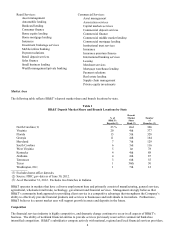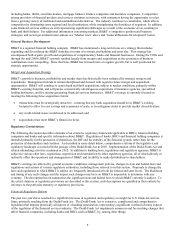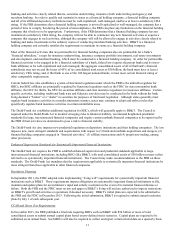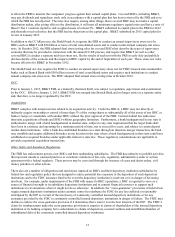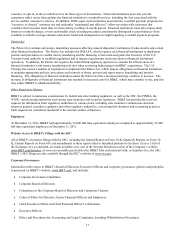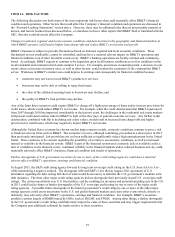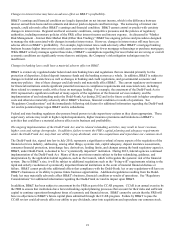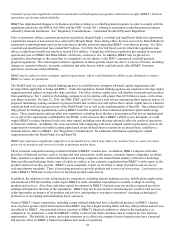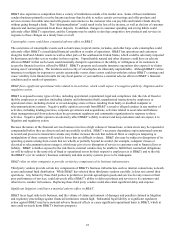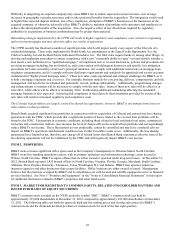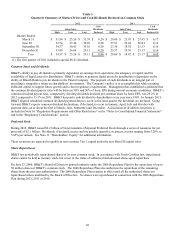BB&T 2012 Annual Report Download - page 39
Download and view the complete annual report
Please find page 39 of the 2012 BB&T annual report below. You can navigate through the pages in the report by either clicking on the pages listed below, or by using the keyword search tool below to find specific information within the annual report.
17
consents, or opts in, to the overdraft service for those types of transactions. Financial institutions must also provide
consumers with a notice that explains the financial institution’ s overdraft services, including the fees associated with the
service and the consumer’ s choices. In addition, FDIC-supervised institutions must monitor overdraft payment programs for
“excessive or chronic” customer use and undertake “meaningful and effective” follow-up action with customers that
overdraw their accounts more than six times during a rolling 12-month period. Financial institutions must also impose daily
limits on overdraft charges, review and modify check-clearing procedures, prominently distinguish account balances from
available overdraft coverage amounts and ensure board and management oversight regarding overdraft payment programs.
Patriot Act
The Patriot Act contains anti-money laundering measures affecting insured depository institutions, broker-dealers and certain
other financial institutions. The Patriot Act includes the IMLAFA, which requires such financial institutions to implement
policies and procedures to combat money laundering and the financing of terrorism and grants the Secretary of the U.S.
Treasury broad authority to establish regulations and to impose requirements and restrictions on financial institutions’
operations. In addition, the Patriot Act requires the federal bank regulatory agencies to consider the effectiveness of a
financial institution’ s anti-money laundering activities when reviewing bank mergers and BHC acquisitions. The U.S.
Treasury has issued a number of regulations to implement the Patriot Act, which impose obligations on financial institutions
to maintain appropriate policies, procedures and controls to detect, prevent and report money laundering and terrorist
financing. The obligations of financial institutions under the Patriot Act have increased and may continue to increase. The
increase in obligations of financial institutions has resulted in increased costs for BB&T, which may continue to rise, and also
may subject BB&T to additional liability.
Other Regulatory Matters
BB&T is subject to numerous examinations by federal and state banking regulators, as well as the SEC, the FINRA, the
NYSE, various taxing authorities and various state insurance and securities regulators. BB&T has periodically received
requests for information from regulatory authorities in various states, including state insurance commissions and state
attorneys general, securities regulators and other regulatory authorities, concerning their business and accounting practices.
Such requests are considered incidental to the normal conduct of business.
Employees
At December 31, 2012, BB&T had approximately 34,000 full-time equivalent employees compared to approximately 31,800
full-time equivalent employees at December 31, 2011.
Website Access to BB&T’s Filings with the SEC
All of BB&T’ s electronic filings with the SEC, including the Annual Report on Form 10-K, Quarterly Reports on Form 10-
Q, Current Reports on Form 8-K and amendments to these reports filed or furnished pursuant to Sections 13(a) or 15(d) of
the Exchange Act, as amended, are made available at no cost in the Investor Relations section of the Company’ s website,
www.BBT.com/Investor, as soon as reasonably practicable after BB&T files such material with, or furnishes it to, the SEC.
BB&T’ s SEC filings are also available through the SEC’ s website at www.sec.gov.
Corporate Governance
Information with respect to BB&T’ s Board of Directors, Executive Officers and corporate governance policies and principles
is presented on BB&T’ s website, www.BBT.com, and includes:
Corporate Governance Guidelines
Corporate Board of Directors
Committees of the Corporate Board of Directors and Committee Charters
Codes of Ethics for Directors, Senior Financial Officers and Employees
Chief Executive Officer and Chief Financial Officer Certifications
Executive Officers
Policy and Procedures for Accounting and Legal Complaints, including Whistleblower Procedures



